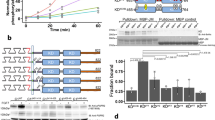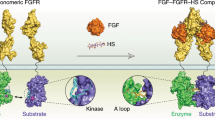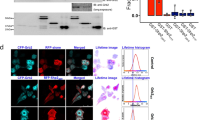Abstract
We have studied the role of protein kinase C (PKC) in signaling of the RET tyrosine kinase receptor. By using a chimeric receptor (E/R) in which RET kinase can be tightly controlled by the addition of epidermal growth factor (EGF), we have found that RET triggering induces a strong increase of PKCα, PKCδ and PKCζ activity and that PKCα, not PKCδ and PKCζ, forms a ligand-dependent protein complex with E/R. We have identified tyrosine 1062 in the RET carboxyl-terminal tail as the docking site for PKCα. Block of PKC activity by bisindolylmaleimide or chronic phorbol esters treatment decreased EGF-induced serine/threonine phosphorylation of E/R, while it caused a similarly sized increase of EGF-induced E/R tyrosine kinase activity and mitogenic signaling. Conversely, acute phorbol esters treatment, which promotes PKC activity, increased the levels of E/R serine/threonine phosphorylation and significantly decreased its phosphotyrosine content. A threefold reduction of tyrosine phosphorylation levels of the constitutively active RET/MEN2A oncoprotein was observed upon coexpression with PKCα. We conclude that RET binds to and activates PKCα. PKCα, in turn, causes RET phosphorylation and downregulates RET tyrosine kinase and downstream signaling, thus functioning as a negative feedback loop to modulate RET activity.
This is a preview of subscription content, access via your institution
Access options
Subscribe to this journal
Receive 50 print issues and online access
$259.00 per year
only $5.18 per issue
Buy this article
- Purchase on Springer Link
- Instant access to full article PDF
Prices may be subject to local taxes which are calculated during checkout








Similar content being viewed by others
References
Besset V, Scott RP and Ibanez CF . (2000). J. Biol. Chem., 275, 39159–39166.
Borrello MG, Alberti L, Arighi E, Bongarzone I, Battistini C, Bardelli A, Pasini B, Piutti C, Rizzetti MG, Mondellini P, Radice MT and Pierotti MA . (1996) Mol. Cell. Biol., 16, 2151–2163.
Carlomagno F, Melillo RM, Visconti R, Salvatore G, De Vita G, Lupoli G, Yu Y, Jing S, Vecchio G, Fusco A and Santoro M . (1998) Endocrinology, 139, 3613–3619.
Caruso M, Maitan MA, Bifulco G, Miele C, Vigliotta G, Oriente F, Formisano P and Beguinot F . (2001). J. Biol. Chem., 276, 45088–45097.
Chen P, Xie H and Wells A . (1996). Mol. Biol. Cell, 7, 871–881.
De Vita G, Melillo RM, Carlomagno F, Visconti R, Castellone MD, Bellacosa A, Billaud M, Fusco A, Tsichlis PN and Santoro M . (2000). Cancer Res., 60, 3727–3731.
Decker SJ . (1984). Mol. Cell. Biol., 4, 1718–1724.
Downward J, Parker P and Waterfield MD . (1984). Nature, 311, 483–485.
Fagin JA . (2002). Endocrinology, 143, 2025–2028.
Farese RV, Cooper DR, Konda S, Nair G, Standaert ML, Davis JS and Pollet RJ . (1988). Biochem. J., 256, 175–184.
Formisano P, Oriente F, Fiory F, Caruso M, Miele C, Maitan MA, Andreozzi F, Vigliotta G, Condorelli G and Beguinot F . (2000). Mol. Cell. Biol., 20, 6323–6333.
Formisano P, Oriente F, Miele C, Caruso M, Auricchio R, Vigliotta G, Condorelli G and Beguinot F . (1998). J. Biol. Chem., 273, 13197–13202.
Fukuda T, Kiuchi K and Takahashi M (2002) J. Biol. Chem., 277, 19114–19121.
Gandino L, Longati P, Medico E, Prat M and Comoglio PM . (1994). J. Biol. Chem., 269, 1815–1820.
Iwashita T, Asai N, Murakami H, Matsuyama M and Takahashi M . (1996). Oncogene, 12, 481–487.
Jaken S . (1996). Curr. Opin. Cell Biol., 8, 168–173.
Jhiang SM . (2000). Oncogene, 19, 5590–5597.
Le Good JA, Ziegler WH, Parekh DB, Alessi DR, Cohen P and Parker PJ . (1998). Science, 281, 2042–2045.
Li W, Jiang YX, Zhang J, Soon L, Flechner L, Kapoor V, Pierce JH and Wang LH . (1998). Mol. Cell. Biol., 18, 5888–5898.
Manie S, Santoro M, Fusco A and Billaud M . (2001). Trends Genet., 17, 580–589.
Melillo RM, Carlomagno F, De Vita G, Formisano P, Vecchio G, Fusco A, Billaud M and Santoro M . (200la). Oncogene, 20, 209–218.
Melillo RM, Santoro M, Ong SH, Billaud M, Fusco A, Hadari YR, Schlessinger J and Lax I . (2001b). Mol. Cell. Biol., 21, 4177–4187.
Mellor H and Parker PJ . (1998). Biochem. J., 332, 281–292.
Nakanishi H, Brewer KA and Exton JH . (1993). J. Biol. Chem., 268, 13–16.
Newton AC . (1997). Curr. Opin. Cell Biol., 9, 161–167.
Nishizuka Y . (1988). Nature, 334, 661–665.
Oriente F, Formisano P, Miele C, Fiory F, Maitan MA, Vigliotta G, Trencia A, Santopietro S, Caruso M, Van Obberghen E and Beguinot F . (2001). J. Biol. Chem., 276, 37109–37119.
Ponder BA . (1999). Cancer Res., 59, 1736–1741.
Preiss J, Loomis CR, Bishop WR, Neidel JE and Bell RM . (1986). J. Biol. Chem., 261, 8597–8600.
Santoro M, Carlomagno F, Romano A, Bottaro DP, Dathan NA, Grieco M, Fusco A, Vecchio G, Matoskova B, Kraus MH and Di Fiore PP . (1995). Science, 267, 381–383.
Santoro M, Wong WT, Aroca P, Santos E, Matoskova B, Grieco M, Fusco A and di Fiore PP . (1994). Mol. Cell. Biol., 14, 663–675.
Seedorf K, Shearman M and Ullrich A . (1995a). J. Biol. Chem., 270, 18953–18960.
Seedorf K, Sherman M and Ullrich A . (1995b). Ann. N. Y. Acad. Sci., 766, 459–462.
Segouffin-Cariou C and Billaud M . (2000). J. Biol. Chem., 275, 3568–3576.
Takayama S, White MF, Lauris V and Kahn CR . (1984). Proc. Natl. Acad. Sci. USA, 81, 7797–7801.
Yaffe MB, Leparc GG, Lai J, Obata T, Volinia S and Cantley LC . (2001). Nat. Biotechnol., 19, 348–353.
Acknowledgements
This study was supported in part by grants from the Associazione Italiana per la Ricerca sul Cancro (AIRC), by the EC grants FIGH-CT1999-CHIPS and QLRT-1999-00674, by the Programma Biotecnologie legge 95/95 (MURST 5%), by BioGeM s.c.ar.l. (Biotecnologia e Genetica Molecolare nel Mezzogiorno d'Italia), by the Ministero dell' Università e della Ricerca Scientifica. The financial support of Telethon — Italy (Grant no. 0896 to FB) is gratefully acknowledged. F Fiory is the recipient of a fellowship of the Federazione Italiana per la Ricerca sul Cancro (FIRC).
Author information
Authors and Affiliations
Corresponding author
Rights and permissions
About this article
Cite this article
Andreozzi, F., Melillo, R., Carlomagno, F. et al. Protein kinase Cα activation by RET: evidence for a negative feedback mechanism controlling RET tyrosine kinase. Oncogene 22, 2942–2949 (2003). https://doi.org/10.1038/sj.onc.1206475
Received:
Revised:
Accepted:
Published:
Issue Date:
DOI: https://doi.org/10.1038/sj.onc.1206475
Keywords
This article is cited by
-
Preclinical Pharmacokinetics and in vitro Metabolism of FHND5071, a Novel Selective RET Kinase Inhibitor
European Journal of Drug Metabolism and Pharmacokinetics (2023)
-
Targeting RET-driven cancers: lessons from evolving preclinical and clinical landscapes
Nature Reviews Clinical Oncology (2018)
-
Differential requirement of Tyr1062 multidocking site by RET isoforms to promote neural cell scattering and epithelial cell branching
Oncogene (2004)
-
Autocrine stimulation by osteopontin plays a pivotal role in the expression of the mitogenic and invasive phenotype of RET/PTC-transformed thyroid cells
Oncogene (2004)



